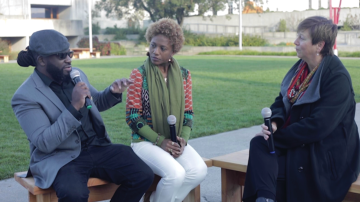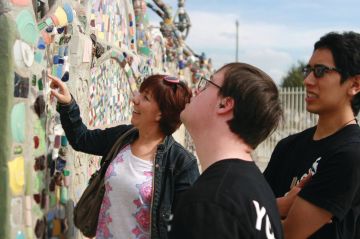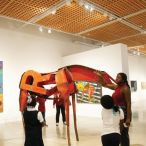
This article originally appeared in Museum magazine’s January/February 2023 issue, a benefit of AAM membership.
How can museums build the workforce they need while creating better, more equitable labor practices?
This is not complicated. If you can’t afford to pay your employees a living wage, you do not have a viable business model.
—Robert Reich
As the world shut down in 2020, unemployment soared to its highest rate since the government started keeping records in 1948. Labor participation crashed to a 50-year low as people left the workforce to care for family and protect themselves and their loved ones. Many of those still working were stressed, fearful, angry, and feeling burnt out.
By summer 2022, worker disengagement and discontent were at an all-time high: 60 percent of employees reported they were emotionally detached at work, and nearly one-fifth were outright miserable. Economist Anthony Klotz coined the term “The Great Resignation” to describe the record number of workers leaving their jobs in this time of trauma—4.3 million in August 2021 alone. Long term, this labor shortage may be exacerbated by the massive effects of long COVID, which potentially affects 31 million working-age Americans.
Given all of this, how can museums attract and retain the workforce they need while building better, more equitable labor practices?
The Challenge
The stress and instability of recent years is causing some people to question ingrained attitudes about the primacy of work. In China and South Korea, this gave rise to the “lying flat” movement in which young people took to social media to extol the virtues of a frugal lifestyle (supported by minimal income). In Atlanta, artist and theologian Tricia Hersey founded The Nap Ministry, a reaction to burnout culture centered in Black liberation. In fall 2022, the media began writing about “quiet quitting,” which, confusingly, sometimes refers to “checking out”—doing the bare minimum required by a job—and sometimes to a healthy practice of drawing firm boundaries around work rather than striving to overachieve.
While the pandemic may have brought growing dissatisfaction about work to a head, reactions such as lying flat, “napping,” or quietly enforcing work-life boundaries reflect long-standing tensions. One might argue they are the inevitable result of increased wealth inequality, social stratification, and a drop in socioeconomic mobility. What is the point of going “over and above” at work when your salary doesn’t cover basic living expenses, much less enable you to pay down student debt? The pandemic also forced us to confront the fact that unless we provide better protection, compensation, and respect, undervalued but essential work (teaching, nursing, providing childcare) may go undone.

Growing resistance to the many deficiencies of the workplace and the rise in the power of labor mean that employers must compete in a tight labor market. This has led to significant changes in how businesses recruit and retain staff. To expand the pool of potential hires, some are rethinking position prerequisites, dropping degree requirements, and explicitly valuing life experience in addition to formal education. (In response to this trend, LinkedIn, a major global platform for recruitment, has introduced a “career breaks” feature to make it easier for candidates to highlight skills and experience they have acquired outside the workplace.) Other companies are looking outside the traditional workforce for skilled workers, including the pool of 72 million people reaching retirement age, many of whom want to continue to work part-time. Entire sectors, notably technology, are capitalizing on the preference for remote work, freeing employees to live where they like.
The competition for labor has pushed up wages—by 4.6 percent in the private sector in 2021—but employers are expanding other incentives as well. In response to data that the top reason for workers quitting was lack of career development, some companies are prioritizing training and establishing mentorship programs. Some companies are helping workers repay student debt, while others are covering tuition for continuing education. In the wake of the Supreme Court’s Dobbs v. Jackson decision, some are even offering to cover travel costs for employees who need to go out of state to seek abortions.
We are only beginning to assess significant long-term changes in work prompted by pandemic disruptions. Legislative efforts in California are seeking to cap a full (non-overtime) workweek at 32 hours (perhaps piloting future changes to the national Fair Labor Standards Act). Some companies are experimenting with the end of the five-day workweek, whether that takes the form of a three-day office week within a longer workweek or four days of work (80 percent of the traditional workweek) at 100 percent salary. These efforts may be supported by research showing that parents, based on pandemic educational experiments, overwhelmingly prefer a four-day school week as well.
There is significant consensus that one massive change driven by the pandemic—the rise of remote and hybrid work—is here to stay. Remote work tripled between 2019 and 2021—to nearly 18 percent of all workers in the US. Research suggests that in coming years from 20 percent to nearly 40 percent of jobs may be fully remote, while 15 percent may be hybrid—with a quarter of work time spent in home offices. There will doubtless be some rebound from the pandemic peak, but some sectors, notably technology, are making remote work a fundamental part of their business model, both as a way to court scarce workers and to save on the costs of expensive real estate.
The untethering of work from geography is reshaping cities across the US. Major urban cores, including New York, Boston, San Francisco, Miami, and Washington, DC, are hollowing out as companies close offices and workers relocate to areas with lower costs of living and higher qualities of life. Many formerly thriving cities are struggling to rebuild their tax base and redevelop downtowns as attractive places to live, shop, and hang out. Some small cities, including Ruston, Louisiana, and Tulsa, Oklahoma, are courting remote workers with financial incentives to relocate. One interesting side effect of this migration might be increased political diversity in the heartland, potentially blurring the boundaries between red and blue America.
What This Means for Museums
The pandemic labor exodus struck the nonprofit sector particularly hard, and as the world reopened for business, this shortage only got worse. In the 2022 Nonprofit Industry Pulse Survey, 69 percent of nonprofits cited staffing challenges, which left social service nonprofits unable to meet acute needs created or exacerbated by the pandemic. In AAM’s 2021 National Snapshot of COVID-19 Impact on US Museums, directors anticipated that one of the biggest disruptions in 2022 would be labor and skills shortages.

This labor shortage stems in part from the terrible toll the pandemic has taken on staff. In the past three years museum workers experienced stress and burnout paralleling that of their nonprofit and for-profit colleagues. Over 40 percent lost income, and nearly half experienced increased workload—with the heaviest burden falling on BIPOC staff and women. Stress, and burnout, may have been exacerbated by the pressure museums felt to innovate their way out of the pandemic. Research from Glassdoor shows that high levels of innovation are a good predictor of employee resignations. This is ironic, in the saddest way, as innovation is what enabled many museums to remain solvent and retain staff. The stress of working in pandemic conditions and the worker empowerment created by the tight labor market may be significant drivers of museum unionization. Workers have formed collective bargaining units at more than two dozen museums in the past three years.
These pressures are leading many museums to think about how to create better, more supportive, and more equitable workplaces. Some practical steps build on lessons learned from diversity, equity, accessibility, and inclusion (DEAI) initiatives: committing to paid internships for a broad range of positions (thereby reducing economic barriers to entering the field) and including salaries in position descriptions (which has been shown to raise women’s pay). Some museums are taking steps to significantly raise salaries, provide flexible work hours, and navigate the technical, legal, organizational, and financial complexities of supporting a widely distributed remote workforce. During the pandemic, more than 80 percent of museums allowed at least some staff to telework, and while this figure continues to drop as the world opens up, 16 percent of directors expect to increase the use of telework going forward.
Museums are also responding to a growing body of research documenting the important role of workplace culture—how workers are managed, coached, and treated—in employee engagement and satisfaction. Promoting diversity, equity, and inclusion; ensuring workers feel respected; and transparent, ethical practices can have a huge impact on satisfaction and retention. Many of these changes have been pragmatic responses to immediate needs—sustaining them in the long term will require a values-based commitment to these reforms.
As museums recover financially and rebuild their staff, some may take this opportunity to reshape their workforce. The Association of Art Museum Directors (AAMD) notes that many museums have used open positions to increase the diversity of their staff and what they were hired to do. For example, AAMD research documented a drop in museum educators in the four-year period between 2018 and 2022. Will these shifts prove to be transitory or enduring?
Museums across the country are also being affected by the demographic shifts transforming their communities. Those in cities being drained by the migration fueled by remote work face the potential loss of visitors, members, donors, staff, and financial support of cash-strapped states and municipalities. Museums in cities competing to attract remote workers can play a role in courting new residents and then welcome them into the museum’s family of friends and supporters.
The pandemic inflicted terrible damage, but it also drew attention to ways that the workplace could be different and, in many ways, better—more flexible and compassionate, more skillful in the use of digital tools to support the work of staff. The lessons museums learned in the past three years may help them become more desirable places to work for decades to come. If remote work continues to grow, as many believe it will, communities may place an even higher value on museums as cultural amenities that help them woo workers who can choose where they want to live. These are seeds of hope museums can tend as they help to build the post-pandemic world.
Museum Examples

The Philbrook Museum of Art is partnering with Tulsa Remote, a recruitment initiative that provides a wide variety of incentives for telecommuters living outside Oklahoma to relocate to Tulsa. Through private events and invitations to ongoing programs, the museum introduces these new residents to the diverse and engaging cultural activities at the museum. Many Tulsa Remote families have become members and regular visitors, and some have gone on to become higher-level members, patrons, and volunteers.

Facing workforce challenges during the pandemic, the Delaware Art Museum broadened its pool of applicants by removing unnecessary requirements from job descriptions and recruiting from outside the museum sector. At the same time, the museum strove to create a “people-centered work culture” that raised morale and increased retention. This included creating policies and practices that ensure strategy and finances are clear and transparent, instituting paid family leave, raising the minimum wage, creating codes of conduct that outline the expectation of respectful behavior in detail, and building new pipelines for advancement.

In 2019, the rising cost of living in the San Francisco Bay Area and competition for labor caused annual staff turnover at the historic house and garden Filoli to soar to 50 percent. This stress, combined with the museum’s goal to “attract and retain a talented team” impelled the organization to make a living wage—now nearly $31 an hour in the Bay Area—the base pay for all positions. Supporting these higher salaries required adding an additional $750,000 to the approximately $9 million operating budget, paid for by increasing revenue from rental events, admissions, membership, and a new group tour program. As of 2022, Filoli’s turnover rate had gone down eightfold to 8 percent.
Museums Might …
- Evaluate how they can improve pay and benefits. Pay not only determines who can afford to work in museums, it sends a clear signal about a museum’s values and priorities. Thoughtful salary benchmarking might include examining compensation data from comparable local and national museums and non-museum jobs that compete for museum labor. While benchmarking is important, decisions about compensation should also be grounded in principles of equity and fairness.
- Consider how compensation practices reflect an organization’s values, particularly regarding equity, fairness, and transparency, which are core elements of workplace culture. While building the overall budget, a museum might evaluate the balance between funds allocated to producing stuff (exhibits, programs, services) and to paying the people who make that stuff. Fair wages may require less stuff, or fewer staff. A growing number of museums are explicitly setting a cap on the pay ratio between the highest and lowest paid positions. This is both more equitable and a strategy for allocating salary dollars to support the museum’s needs.
- Follow the lead of organizations in the nonprofit sector that are offering flexible and hybrid work schedules or full-time remote work, prioritizing employee needs, improving DEAI, and even cutting work hours. Such actions can help compensate for museums’ competitive disadvantage in pay relative to the for-profit sector.
- Improve workplace culture—communications, mechanisms for meaningful input, sharing responsibility and power, and reducing unfair treatment at work (which is one of the biggest contributors to burnout).
- Create pathways to advancement and provide leadership training in order to keep people in the field. This is especially important in light of potential turnover in the field, accelerated by the pandemic. In a 2021 AAM survey, over half of paid staff said it was somewhat to highly unlikely they would still be working in the museum sector in three years.
- Revisit assumptions about degree requirements. A museum might broaden its pool of qualified applicants by valuing experience in addition to formal education and welcoming historically undervalued workers, including retirees, formerly incarcerated individuals, and people with disabilities.
- Evaluate how remote work might fit into the workplace, and the effect remote work policies might have on equity and inclusion. How can the museum offset the documented tendency for remote and hybrid workers to be passed over for promotions and raises? Conversely, how can it address the inequities of only some staff or some positions being eligible for remote work?
- If the museum does offer remote and hybrid work, focus on how to enhance and support internal connections. Help workers who rarely meet in person get to know each other and foster a culture of belonging and trust.
- Create support mechanisms for staff coping with long COVID. As with most accommodations, these changes may turn out to be good for all workers, improving morale, reducing turnover, and increasing productivity.
- Help communities respond to demographic shifts. Museums might help reshape former business districts into vibrant centers for residents and recreation, pitching their communities as destinations for people who can work anywhere.
Resources
The US Labor Shortage: A Plan to Tackle the Challenge, Committee for Economic Development: The Public Policy Center of the Conference Board, April 2022
Many of this report’s recommendations about recruitment, hiring, and workforce development are relevant to museum operations.
ced.org/solutions-briefs/the-us-labor-shortage-a-plan-to-tackle-the-challenge
Museums Moving Forward (MMF)
MMF is a staff-driven coalition working to measure and support equity within museum workplaces. MMF recently fielded a pilot survey across 54 museums with 1,922 art museum staff sharing their perspectives that will be published in a fieldwide report in May 2023. Key topics include pay and promotion rate equity, salary transparency, and various dimensions of organizational culture in art museums.
museumsmovingforward.com








